Great Sites: When the Web is the Brand

In early November, contributing editor Clay Andres gave a talk in Brussels, Belgium, in which he proposed that Web sites do not merely convey a company’s brand but rather the Web site becomes the brand itself. In his lecture at the Vlerick Leuven Gent Management School’s Academic Centre for Inter@ctive Marketing, he discussed many sites – some of which he has written about for creativepro.com – and assessed their effectiveness. Here are excerpts from Clay’s talk.
Comparisons are often made between TV and the Web. Both were conceived as media for disseminating information. The commercial possibilities were not considered in the initial work. It took marketing people to see the real possibilities for these once new and esoteric technologies. My wife’s grandfather was one of the first program directors at CBS Television in the ’40s. He was an intellectual, a man of letters who was famous for his erudite arts criticism. Scholarship was considered the perfect qualification for leading this thinking-persons’ world. Can you imagine such a person in TV today?
Similarly, do you think that Tim Berners-Lee and his physicist colleagues at CERN considered for a moment the needs of the average shopper when they defined the Hypertext Markup Language and invented the World Wide Web? Instead, they gave us a chaotic world that gains its strengths by ignoring everything we have been taught is right and good.
The Web is chaotic. It defies authority and all attempts to control it. The bad and the beautiful exist on equal footing. Energy is derived from opposing forces with seemingly nothing in common. It is the description of a world that only a physicist could fathom and really appreciate. Yet we have literally sunk billions of dollars to make this not-quite infinite but exponentially expanding universe into something seminally useful to society.
We have thought about the possibilities, but we have yet to achieve them. We have based our business and marketing plans on these possibilities, but how many of these plans have come close to being an accurate prediction of the future? We had to start somewhere and now we have the experience of our mistakes to help us avoid the same errors in the future. The Web is a no less great or exciting place to do business than it has ever been. How do we make money doing it? Unfortunately, making money is not within my field of expertise, so I’ll have to leave the answer to this question to others.
On the other hand, I know what it takes to make a compelling, timely, interesting, and even useful Web site so that you as marketing and sales people can at least have a decent chance of using the Web to your advantage. When I started writing my book, “Great Web Branding,” which, by the way, should be published by Rockport Publishers in a few months, I wasn’t even sure what Web branding meant. I had to define it for myself. What I discovered is that there is no one thing that is Web branding. …
Apple: Design is the Product
Here’s an obvious example of a distinguished Web brand that transcends the product being sold: Apple Computer (Figure 1). The company does the same thing with its Web site that it does with its products. The personal computer market is a sea of mediocre industrial design and this is reflected in Web sites. Dell, Compaq, Gateway — the sites all look about the same and behave about the same (Figures 2, 3, and 4). These sites are designed by engineers for other engineers. It’s up to the software developers to make the machines palatable to business users. IBM is a notable exception, but their site is focused more on business services than on selling PCs (Figure 5).

Figure 1

Figure 2
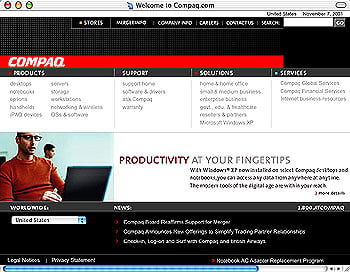
Figure 3
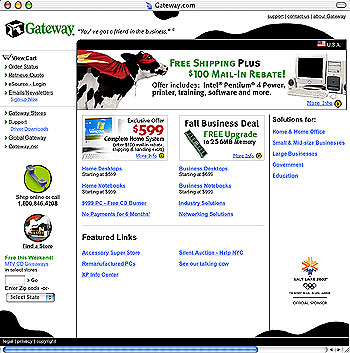
Figure 4
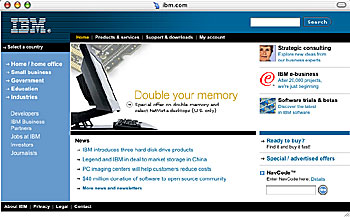
Figure 5
Apple’s site is focused on the user experience, and it is very much an Apple-branded experience. The design of all the pages reflects the aqua interface of Apple’s latest operating system, OS X. There’s extensive use of 3D icons and transparency. All the headings are implemented as GIF images using Apple’s corporate typeface, Garamond Condensed. You wouldn’t need a logo on this page to know that it was part of Apple’s site (Figure 6).
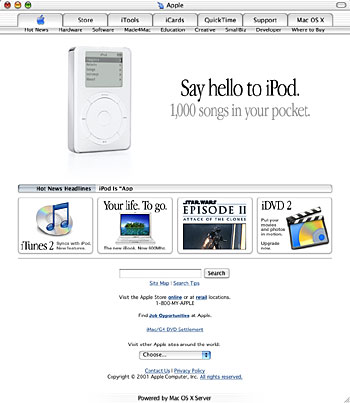
Figure 6
Apple establishes a positive, strongly branded look right away, but how do they translate the Apple experience into HTML? They don’t appear to be doing anything fancy at the top level. There’s no Flash, no animations, the buttons don’t even have rollovers. There’s a JavaScript scroller showing the “Hot News Headlines,” but there’s something much more important going on in the background – the primary image changes each time you view the page. At any given time, Apple will have five or six featured products and a different one pops up in the featured area when the home page is reloaded.
The programming behind this is a simple randomizing script, but the marketing is almost insidiously sophisticated. Every image is beautiful. All the text is honed to a barely descriptive, but highly suggestive minimum. Apple’s marketing savvy is as finely tooled as their computer cases. Looks are important.
Equally important to Web sites, though, is functionality. Apple’s approach is a combination of hierarchical links, non-hierarchical jumps, and searching. A site the size of Apple’s with a great quantity of technical information needs comprehensive search capability, and the Search field anchors the main content area of the page.
More importantly, the tab bar and secondary navigation bar underneath it are fixed features on every page of the site. These functionally similar bars provide two levels of navigation. Furthermore, while these look like hierarchical links, where every tab represents a different division of the site, Apple’s navigation is driven by the demands of marketing. So while iTools and iCards receive their own tabs, iCards is actually a section within the iTools division (Figure 7).
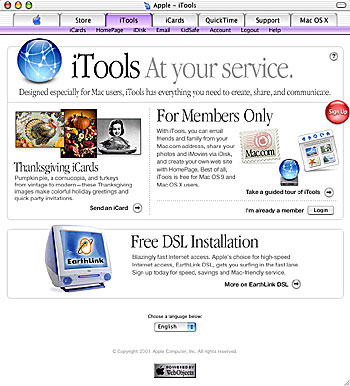
Figure 7
As you proceed through the site, the secondary navigation bar changes to reflect the current tab selected. More importantly from a branding perspective, each tabbed division is color-coded. The color choices are aesthetically pleasing, but the real significance of this is that Apple is creating sub-brands within the Apple domain. Branding is more important than the generally perceived need to conform to a strictly hierarchical arrangement and navigation of pages. QuickTime, iTools, and Mac OS X all receive special treatment as significant brands — the names, the logos, and the color associations. Yet everything is still clearly and consistently Apple.
Monster.com: The Seriousness of Humor
We all know without blinking that strong brands require consistent marketing and an incessant search for eyeballs. Monster.com is a heavily marketed job referral site (Figure 8). They’ve taken out absurdly expensive ads during the broadcasts of the last two American Super Bowls. In my book, “Great Web Branding,” I refer to this event as the Super Branding Bowl, because the ads are more interesting than the football game.

Figure 8
Monster is all about attracting eyeballs, literally. Their success depends on maximum penetration in job markets all over the world, even Belgium! Just look at its logo. There’s the monster’s eye in a bold purple swirl. The same purple is used for the dot in .com and purple shows up in both HTML and GIF text all over the site (Figure 9).
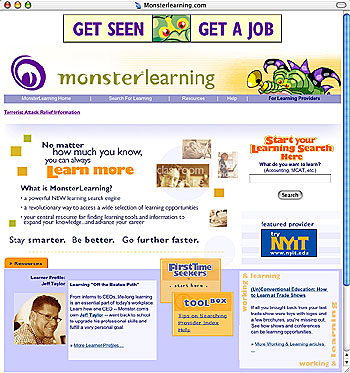
Figure 9
But it’s not just about color. This monster is an absurd creature. It has nothing to do with jobs and it’s just plain silly looking. That’s the hook. This is not your average, deadly dull job-to-applicant matching agency. The point they’re trying to sell is that your job should be fun, and so should finding a job.
The monster and eyeball imagery are everywhere. Each of the hierarchical divisions of the site is represented by a different silly monster, and each monster has significant eyes – so significant that eyeball icons in circles are used to represent links to each division (Figure 10).

Figure 10
This is another way to create brands for each site division, while at the same time strengthening the overall brand image. And while the functionality of this site, the ease with which job listers and job seekers can find matches, is ultimately the way the success of this site will be measured, the image of sophisticated-yet-fun humor provides the immediate attraction. …
Brands New Web
The Web is undoubtedly a new medium, but old rules still apply. The biggest difference is that a company’s Web site becomes its own brand. Once you recognize this fact, the design of sites takes on a whole new dimension. So we have the old business rules, most notably for this conference, the necessity for generating return on investment.
I submit that you must create your business domains from the start with branding in mind in order to maximize your return. Obviously, user experience and content are the keys to usability, but usability is enhanced by establishing a clear brand identity.
Furthermore, branding a Web site requires more than a simple logo or label. All aspects of the page and the site work together to create the Web brand. The imagery, typography, navigational elements, and even the content itself are part of the brand.
When you stop to reflect on this, you realize that every element on the page expresses your brand. You can create endless pages of content, but if you don’t consider how this content enhances the goals of the site, you’re losing an opportunity to clarify the brand message.
Obviously, one can take branding to absurd extremes. But my point is that when it comes to branding Web sites, all aspects of branding can be considered. You don’t need to use every trick for every site, but you will only find the most appropriate brand elements by considering all your options.
I don’t believe it’s possible to create a Web brand or to brand a Web site without considering issues of branding from the start. At the same time, I don’t think there are any really good sites that aren’t also well branded. There are certainly useful-but-poorly-designed sites, but how much more useful would these be if well designed? Good business design inherently incorporates branding and — we’re back with my initial supposition — good sites require good branding.
Read more by Clay Andres.
This article was last modified on January 6, 2023
This article was first published on November 12, 2001



